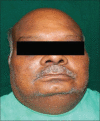Rhinocerebral mucormycosis associated with actinomycosis in a diabetic patient: A rare presentation
- PMID: 30967740
- PMCID: PMC6421906
- DOI: 10.4103/jomfp.JOMFP_77_18
Rhinocerebral mucormycosis associated with actinomycosis in a diabetic patient: A rare presentation
Abstract
Mucormycosis is an opportunistic fulminant fungal infection which mainly affects the immunocompromised individuals. It begins in the nose and paranasal sinuses due to the inhalation of fungal spores. The common predisposing factors include diabetes mellitus and immunosuppression. Actinomycosis is a bacterial infection caused by nonspore-forming, anaerobic or microaerophilic bacterial species of the genus Actinomyces. It is a suppurative and chronic granulomatous disease characterized by abscess formation, tissue fibrosis and draining sinuses rarely diagnosed in humans. A case of rhinocerebral mucormycosis associated with actinomycosis of the maxilla involving the palate in an uncontrolled diabetic patient is reported.
Keywords: Actinomycosis; diabetes mellitus; maxilla; mucormycosis.
Conflict of interest statement
There are no conflicts of interest.
Figures






References
-
- Pandey A, Bansal V, Asthana AK, Trivedi V, Madan M, Das A, et al. Maxillary osteomyelitis by mucormycosis: Report of four cases. Int J Infect Dis. 2011;15:e66–9. - PubMed
-
- Roden MM, Zaoutis TE, Buchanan WL, Knudsen TA, Sarkisova TA, Schaufele RL, et al. Epidemiology and outcome of zygomycosis: A review of 929 reported cases. Clin Infect Dis. 2005;41:634–53. - PubMed
-
- Khan S, Jetley S, Rana S, Kapur P. Rhinomaxillary mucormycosis in a diabetic female. J Cranio Maxillary Dis. 2013;2:91–3.
-
- Sujatha RS, Rakesh N, Deepa J, Ashish L, Shridevi B. Rhino cerebral mucormycosis. A report of two cases and review of literature. J Clin Exp Dent. 2011;3:e256–60.

